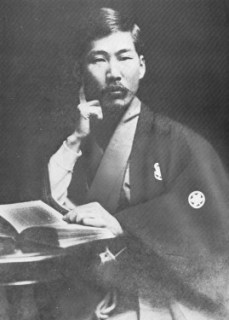Still working to recover. Please don't edit quite yet.
ShÅ«sui KÅtoku
ShÅ«sui KÅtoku, 幸徳 秋水, KÅtoku ShÅ«sui, November 4 or September 23, 1871 – January 24, 1911 was a socialist and anarchist who played a leading role in introducing anarchism to Japan in the early 20th century, particularly by translating the works of contemporary European and Russian anarchists, such as Peter Kropotkin, into Japanese. He was a radical journalist and is often considered an anarchist martyr, as he was executed for treason by the Japanese government.
Contents
[hide]Biography[edit]
Socialist years and imprisonment[edit]
KÅtoku moved from his birthplace, the town of Nakamura in the Kochi prefecture, to Tokyo in his mid-teens and became a journalist there in 1893. From 1898 onwards he was a columnist for the Every Morning News, one of the more radical daily papers of the time; however, he resigned that position when the paper switched to a pro-war stance in October 1903 in the build up to the Russo-Japanese War.
The following month he co-founded the Common Peoples' Newspaper with another Every Morning News journalist, Toshihiko Sakai. This paper's outspoken anti-war stance and disregard of the state's press laws landed its editors in trouble with the government on numerous occasions, and KÅtoku himself served a five month jail sentence from February to July 1905.
America and the anarchist influence[edit]
In 1901, when KÅtoku together with Sakai took part in the first attempt to found the Japanese Social Democratic Party, he was not an Anarchist, but a Socialist — indeed, Sakai and KÅtoku were the first to translate The Communist Manifesto into Japanese, which appeared in an issue of the Common People's Newspaper and which got them heavily fined.
His political thoughts first began to turn to a more libertarian philosophy when he read Kropotkin's Fields, Factories and Workshops in prison. In his own words, he "had gone [to jail] as a Marxian Socialist and returned as a radical Anarchist."[1]
He had taken Kropotkin's Memoirs of a Revolutionist as reading material for the Pacific voyage; after he arrived in California, he began to correspond with the Russian anarchist and by 1909 had translated The Conquest of Bread from English to Japanese.
One thousand copies of his translation were published in Japan in March of that year and distributed to students and workers.
Return to Japan[edit]
On KÅtoku's return to Japan, in June 1906, a public meeting was held to welcome him. At this meeting, on June 28, he spoke on "The Tide of the World Revolutionary Movement", which he said was flowing against parliamentary politics (ie. Marxist party politics) and in favour of the general strike as "the means for the future revolution."
This was an anarcho-syndicalist view, and one which, because anarcho-syndicalism was growing in the US at the time, with the founding of the Industrial Workers of the World, showed the American influence clearly.
He followed this speech with a number of articles, the most well-known of which was "The Change in My Thought (On Universal Suffrage)". In these articles, KÅtoku was now advocating direct action rather than political aims such as universal suffrage, which was a shock to many of his comrades and brought the schism between Anarchist Communists and Social Democrats to the Japanese working class movement.
This split was made clear when the relaunched Common People's Newspaper folded in April 1907 and was replaced two months later by two journals: the Social Democrat Social News and the Osaka Common People's Newspaper, which argued from an Anarchist position, in favour of direct action.
Trial And Execution[edit]
Although most Anarchists preferred peaceful means, such as the dissemination of propaganda, many Anarchists in this period turned to terrorism as means of achieving revolution and Anarchist Communism, or at least hitting out against the state and authority. Repression of publications and organizations, such as the Socialist Party of Japan, and "public peace police law", which effectively prevented trade union organizations and strikes, were both factors in this emerging trend in Japan.
In the episode which became known as The High Treason Incident (Taigyaku Jiken), police arrested five Anarchists for possessing bomb making equipment, which was allegedly intended for a plot to assassinate the Emperor.
This was followed by a big wave of arrests of political dissidents, of whom KÅtoku was probably the most well-known and prestigious. Though there was conclusive evidence only against five, on January 18 1911 twenty-six Anarchists were convicted - mostly on circumstantial evidence. Twenty-four of them were sentenced to death, eleven of whom were actually executed - KÅtoku among them. While he may have known of the plot to kill the Emperor in its initial stages, he had certainly distanced himself from it.
KÅtoku was hanged along with ten others on 24 January, 1911 (the one woman, Suga Kanno, was executed the following day because it had already turned dark, not for reasons of delicacy).
His execution was widely regarded as a miscarriage of justice, though in 1965 the Japanese Supreme Court refused a plea to reopen his case and that of the others executed with him and he is remembered as a martyr by Japanese Anarchists and Anarchists world-wide, sometimes being compared with Sacco and Vanzetti.
Notes[edit]
- Jump up ↑ THE ANARCHIST MOVEMENT IN JAPAN - Chapter One: 1906-1911 at www.spunk.org
External links[edit]
- The Anarchist Movement in Japan, a pamphlet by John Crump and one source for this article.
- e-texts of KÅtoku's works at Aozora bunko
| This article contains content from Wikipedia. Current versions of the GNU FDL article ShÅ«sui KÅtoku on WP may contain information useful to the improvement of this article | WP |
